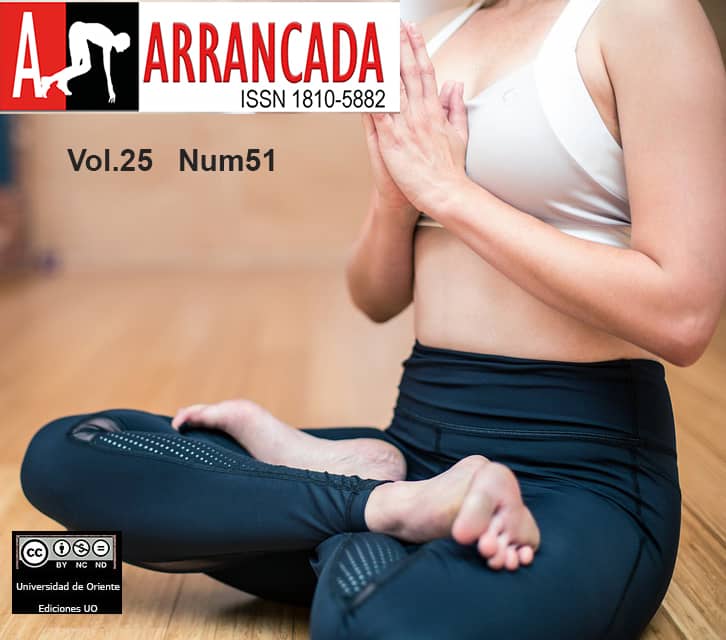Methodological strategies for teaching freestyle to young swimmers (Aged 9 to 11) in a regional club
Keywords:
biomechanics, sport movement, phases, freestyle, swimming, technique.Abstract
This study addresses the teaching of freestyle (crawl) to children aged 9 to 11, with an emphasis on the application of methodological techniques and the use of pedagogical and scientific assessment tools. Through a quantitative approach, an intervention was designed that incorporated progressive activities, an observation guide, surveys for coaches and parents, and statistical analysis using pretest and posttest evaluations. Thirty children from a regional swimming club participated, divided into a control group and an experimental group. The study followed a quasi-experimental design with an explanatory scope, focusing on evaluating technical improvement in freestyle after an eight-week intervention. Results showed statistically significant improvements in the experimental group in variables such as arm-leg coordination, body position, and breathing pattern. Techniques used included structured observation, Likert-scale surveys, and analysis using paired-sample t-tests. The evaluation was conducted by certified coaches and analyzed using Student’s t-test for both independent and related samples, with a significance level of p < 0.05. Additionally, effect size was calculated using Cohen’s d. The findings support the effectiveness of a structured and segmented teaching approach, utilizing audiovisual resources and specific exercises. The results were compared with similar studies by authors such as Maglischo (2019), Arellano (2017), and Counsilman (2002), showing alignment with their conclusions on the importance of technique from early ages.
Downloads
References
Arellano, R. (2019). La técnica en la natación moderna: fundamentos y aplicación. Editorial INDE.
Bompa, T., & Haff, G. (2021). Entrenamiento deportivo para jóvenes atletas. Paidotribo.
Counsilman, J. E., & Counsilman, B. E. (2020). Biomecánica aplicada a la natación. Editorial Médica Panamericana.
Delgado, M., & Romero, A. (2022). Evaluación del aprendizaje motor en natación mediante grabación de video. Revista de Ciencias del Deporte, 17(2), 43–51. https://doi.org/10.1234/rcd.v17i2.2022
García, F., Ibáñez, C., & López, S. (2022). Rol de los padres en el proceso formativo de nadadores infantiles. Revista de Educación Física y Deportes, 9(3), 67–74.
Gonjo, T., Narita, K., McCabe, C., Fernandes, R. J., & Vilas Boas, J. P. (2020). Front crawl is more efficient and has smaller active drag than backstroke swimming: Kinematic and kinetic comparison between the two techniques at the same swimming speeds. Frontiers in Bioengineering and Biotechnology, 8, 570657. https://www.frontiersin.org/articles/10.3389/fbioe.2020.570657/full
Grosser, M. (2020). Psicología del aprendizaje motor. Paidotribo.
Landis, J. R., & Koch, G. G. (1977). The measurement of observer agreement for categorical data. Biometrics, 33(1), 159–174.
Maglischo, E. (2019). Swimming fastest. Human Kinetics.
Medina, T., & Vargas, C. (2020). Aplicación del pretest y postest en programas de enseñanza del estilo libre. Revista Movimiento, 12(1), 22–29.
Mittal, R., Dong, H., & Najjar, F. (2012, June 25). In elite swimming, paddlers are more efficient than propellers. The Johns Hopkins Gazette. https://gazette.jhu.edu/2012/06/25/paddle-vs-propeller-which-competitive-swimming-stroke-is-superior/
Moreno, R., & Villanueva, R. (2021). Eficacia de una guía de observación estructurada en el aprendizaje de estilos de natación. Revista Iberoamericana de Psicología del Deporte, 16(2), 103–110.
Navarro, F., & Ortega, J. (2020). Estrategias activas para la enseñanza de la natación en edad escolar. Educación Física y Ciencia, 22(3), 95–107.
Peña, J., & Pérez, G. (2021). Métodos mixtos en la evaluación técnica del estilo libre. Cuadernos de Entrenamiento Deportivo, 10(4), 31–39.
Polach, M., Thiel, D., Kreník, J., & Vodička, T. (2021). Swimming turn performance: The distinguishing factor in 1500 m world championship freestyle races. BMC Research Notes, 14, 248. https://doi.org/10.1186/s13104-021-05665-x
Pollen, T. R., Ebaugh, D., Mohring, J. H., & Silfies, S. P. (2020). Is better freestyle swimming technique associated with competitive performance? Medicine & Science in Sports & Exercise, 52(7S), 1036. https://www.ncbi.nlm.nih.gov/pmc/articles/PMC10072098/
Polit, D. F., & Beck, C. T. (2006). The content validity index: Are you sure you know what’s being reported? Critique and recommendations. Research in Nursing & Health, 29(5), 489–497. https://doi.org/10.1002/nur.20147
Platonov, V. (2020). La teoría general del entrenamiento deportivo. Paidotribo.
Rodríguez, J., & Sánchez, L. (2021). La enseñanza diferenciada en natación infantil. Revista de Didáctica del Deporte, 14(2), 56–64.
Vargas, C., & Medina, T. (2020). Diseño de instrumentos de medición del progreso técnico en natación. Revista Internacional de Ciencias del Deporte, 18(1), 45–53.
Zambrano, D., Ortega, J., & Rodríguez, F. (2021). Feedback visual en el aprendizaje técnico en natación. Revista Digital de Entrenamiento y Deporte, 7(1), 75–83.
Shrout, P. E., & Fleiss, J. L. (1979). Intraclass correlations: Uses in assessing rater reliability. Psychological Bulletin, 86(2), 420–428. https://doi.org/10.1037/0033-2909.86.2.420
Published
How to Cite
Issue
Section
License
Copyright (c) 2025 Gonzalo Garcia Menendez, María José Peralta Machado, Danilo Charchabal Pérez

This work is licensed under a Creative Commons Attribution-NonCommercial-NoDerivatives 4.0 International License.
This journal provides immediate open access to its content, based on the principle that providing the public with free access to research supports a greater global exchange of knowledge.
In addition, open arbitration papers are accepted, preferably from Research Gate.




































